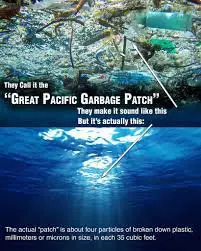Introduction
Quick Navigation
In 1997, huge piles of plastic were found accumulated offshore. There were different zones in which this occurred; however, the Great Pacific struck environmentalists the most.
The Great Pacific Garbage Patch also called the Pacific Trash Vortex, is the world’s largest offshore plastic accumulation zone. It is found in the central North Pacific Ocean and spans across over 1 million square miles. This Patch is divided into two different areas – Western and Eastern Garbage Patches. Each area has its neighboring cities or countries.
For instance, the Western Garbage Patch extends between the Hawaiian Islands and Japan, while the Eastern Garbage Patch is between Hawaii and California. However, both areas are linked by the North Pacific Subtropical Convergence Zone. This linking doesn’t come without spinning debris and warm water from the South Pacific that mixes with cool water from the Arctic. Slowly, debris moves from one patch to the other every year.
Where is the Current Location of the Great Pacific Garbage Patch?
The precise location of the Garbage Patch is undefined because different factors contribute to its existence. The two most common factors are currents and winds. However, based on predictions following simulating concentration levels, it is likely to be at the North Pacific Subtropical Gyre.
The North Pacific Subtropical Gyre
According to the National Oceanic and Atmospheric Administration (NOAA), the term “Gyre” means a huge mass of circulating currents. It also refers to floating garbage islands of the oceans.
Currently, the various oceans of the world have 5 gyres – the Indian Ocean Subtropical, North and South Pacific, North and South Atlantic Gyres.
The Great Pacific Garbage Patch is in one of these gyres – the North Pacific Subtropical. This gyre is formed by four different currents moving in a clockwise direction over a water area up to 12.4 million square miles. These currents include the Kuroshio, the North Pacific, the North Equatorial, and the California.
Amid these currents is a seemingly stable gyre that attracts debris and plastics from different ends of the world. As they became trapped in this location, they slowly formed a huge pile of plastics which ultimately turned to the garbage patch the world is dealing with today.
How Did These Plastics or Waste Find their Way to the Ocean?
Every year, environmental-approved agencies record several million tons of waste in the environment – both terrestrial and marine. According to reports, it is estimated that the oceans alone bear over 100 million tons of plastic waste, thereby destroying lives living in water.
Unfortunately, plastics are used by both industries and consumers, making them actively available in the environment. More so, they do not disintegrate easily, so they end up in the oceans of the world. It is believed that over 2 million tons of plastics enter the oceans from rivers yearly; thus, they always find a way of ending up in the ocean.
They finally get broken down by various factors, such as sunlight, current waves, and marine life on entry to the gyre. The breaking down of plastics by these environmental factors is called Photodegradation. These microplastics are some of the things that formed the Great Pacific Garbage Patch.
If you’ve always thought the Patch is a huge pile of dirt, now you know better that it comprises debris, microplastics, and dirt.
How Has Ocean Plastics Affected Marine Ecosystem?
The biggest threats to the oceans are the Great Pacific Garbage Patch and Ocean Plastics. Since both of them are related interdependently, there is a hugely adverse effect on marine life. Different animals exist underwater, and that means their feeding habits and relations also differ.
In some cases, you will find these marine animals ingest plastic waste for food; if that happens, the digestive system gets damaged eventually. If they keep on with the act, there is a chance that they die from malnutrition or the toxic effect of plastics. The decline in the population of these marine animals affects others who depend on them for food; hence, the marine ecosystem becomes unstable.
What Can Be Done to Tackle Great Pacific Garbage Patch?
The Great Pacific Garbage Patch is the largest body of waste on the ocean, and if not tackled sooner, it could affect the habitability of our entire world. Unfortunately, it isn’t that easy to tackle because of its size and scale.
As of the moment, the financial burden is so much that countries at the coastline are reluctant to take up the task. According to the National Ocean and Atmospheric Administration’s Marine Debris Program, over 67 ships will be needed yearly to clean up about 1% of the ocean, i.e., the North Pacific.
Nevertheless, some measures can be taken to prevent and protect the world’s oceans from a menace like this occurring again. One of them is the reduction of plastic use – or recycle, and reuse. Alternatives to plastics are also welcomed.
See here on how to combat ocean plastics actively.
The Ocean Cleanup Program
Currently, a nonprofit organization is tackling the Great Pacific Garbage Patch – The Ocean Cleanup Program. This program aims to clear a huge percentage of ocean plastics to make the oceans habitable for life.
The Ocean Cleanup Program is founded by Boyan Slat, who plans to develop a technology that will extract plastics successfully from the ocean. This technology will also work to intercept plastics from various sources, such as rivers.
If this project becomes successful, it would be a good thing for our world.
Conclusion
From this article, there is so much to do in the world today, especially that it concerns the oceans. The Great Pacific Garbage Patch is one of our many problems, but solving it would be a huge relief. In conclusion, everyone needs to join hands to make sure the world becomes safe and habitable again.

